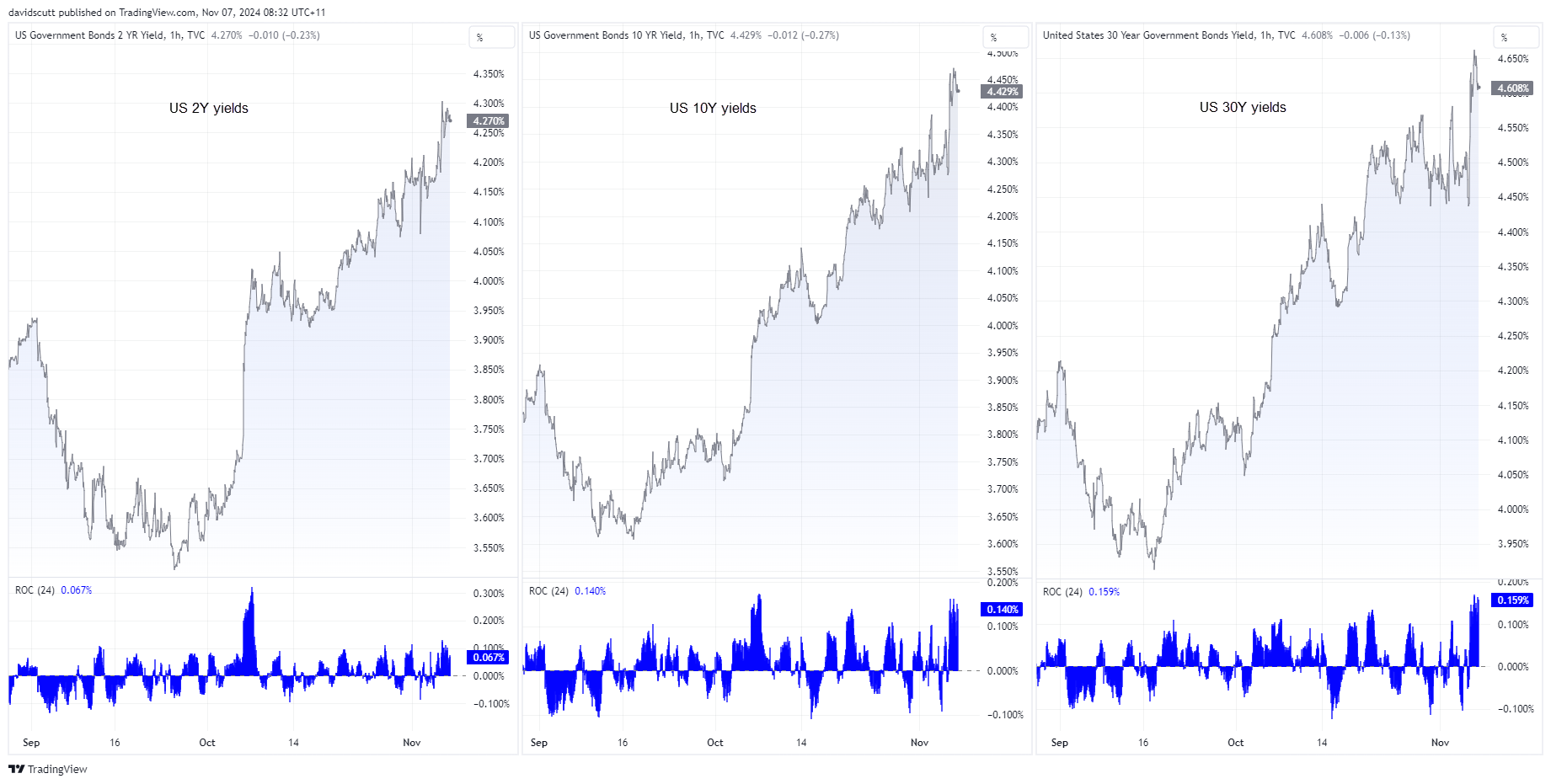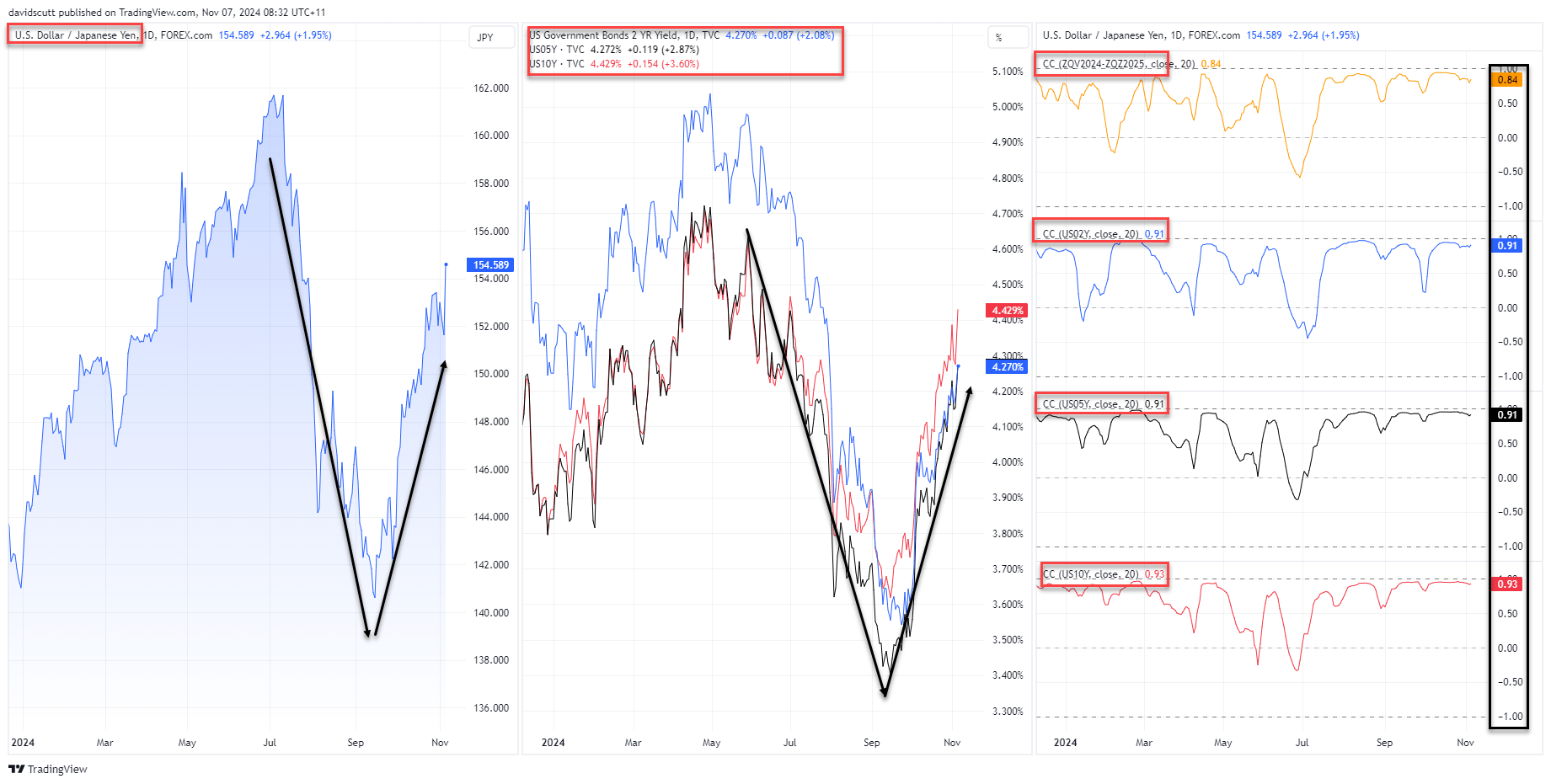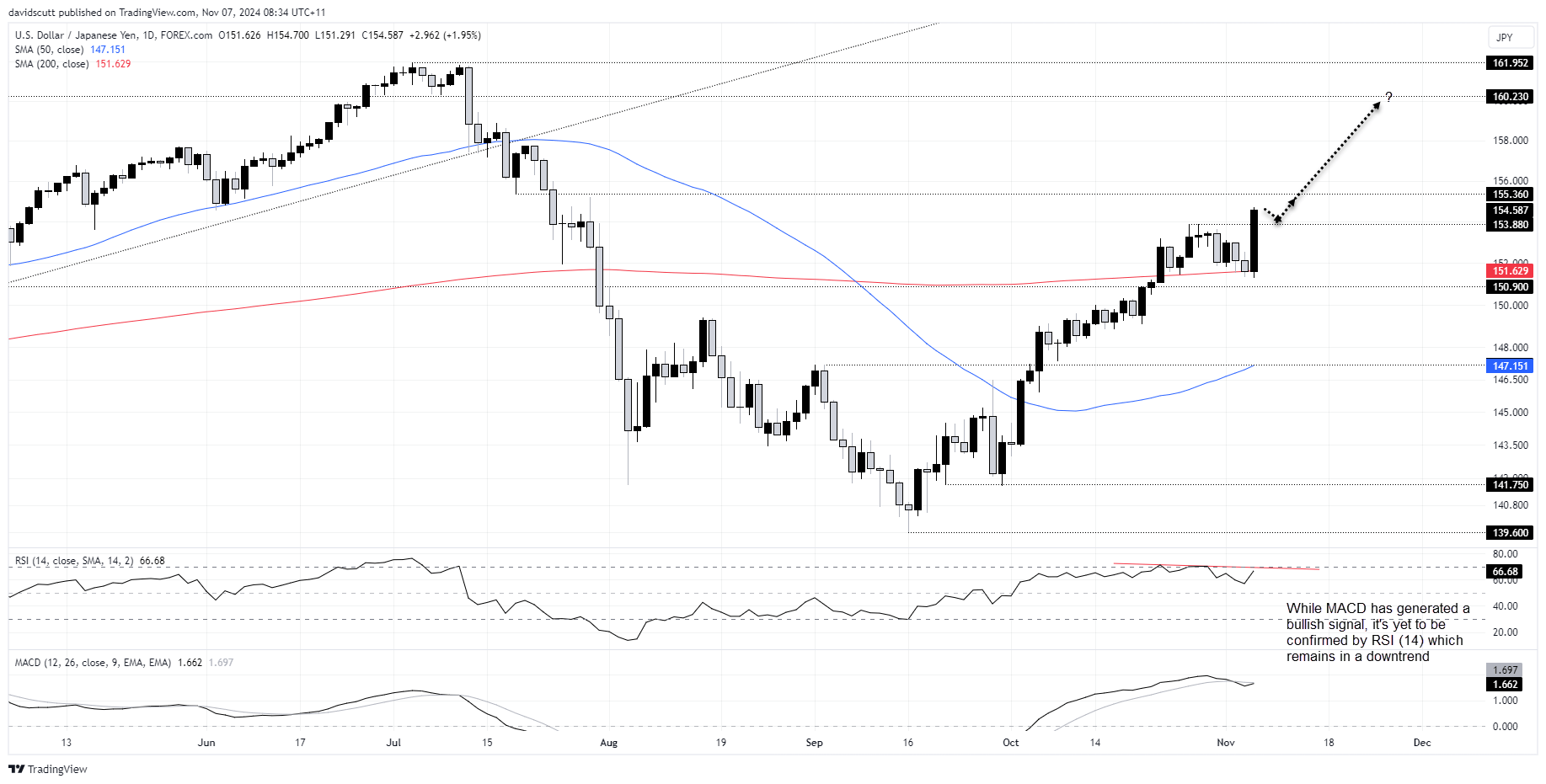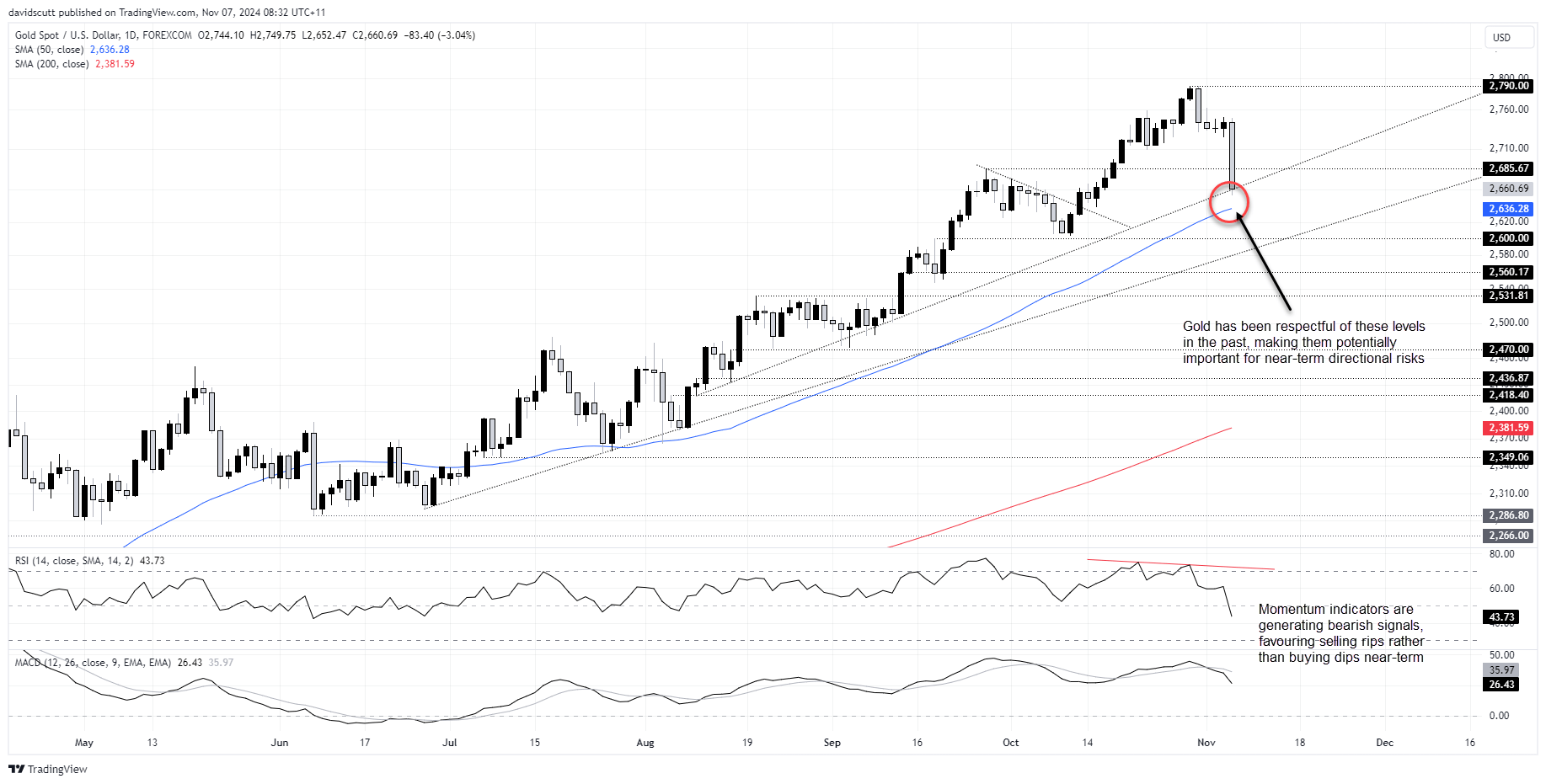- USD/JPY surge driven by stronger US dollar, higher yields
- Gold under pressure as rising rates dent demand
- Fed rate cuts in doubt post-election fiscal outlook
- Key levels for USD/JPY, gold to watch in the near term
Overview
The Japanese yen (USD/JPY) and gold (XAU/USD) price were hit hard by Donald Trump’s thumping victory in the US presidential election, driving a wave of US dollar strength and significantly higher US Treasury yields as the Republicans closed in on a Congressional clean sweep. Now that the uncertainty surrounding the election has passed, this note will examine the implications for USD/JPY and gold as we approach year-end.
US Treasury Yields React to Expansionary Fiscal Outlook
Amid the huge moves in stock and FX markets in response to the election result, one of the most underappreciated market moves was the significant selloff in the US Treasury market. With Trump’s fiscal plans being highly expansionary, including the removal or reduction of corporate and personal taxes, the prospect of faster economic growth, higher inflation, and larger fiscal deficits pushed yields higher across the entire US interest rate curve.
The chart below tracks the movement in US 2-year, 10-year, and 30-year Treasury yields since September, with the bottom pane showing the change over the past 24 hours.
Source: TradingView
While yields hit fresh multi-month highs across all tenors, the selloff at the long end of the curve was the most pronounced as investors demanded increased compensation given the prospect of higher inflation and greater Treasury issuance.
Inflationary Environment Expected
Traders expect stronger inflation, as seen in the US inflation breakevens, which measure market views on average annual inflation over a set period. They spiked on the election result with the 10-year rate, shown below, pushing back to levels where policymakers at the Federal Reserve were previously reluctant to commit to rate cuts.
Source: Refintiv
Fed Rate Cut Bets Slashed
While a Trump presidency and probable Republican clean sweep is unlikely to derail a rate cut from the Fed tomorrow with markets nearly fully priced for a 25-point move, looking further ahead, doubts are creeping in about the scale of easing the Fed will need to deliver.
The next chart examines the shape of the Fed funds futures curve between two dates to assess how overnight borrowing costs are expected to evolve. The left-hand chart measures expectations for the remaining two meetings this year, implying only around a 70% chance of another 25-point move in December.
Looking from now until the end of next year, just four 25-point cuts are expected. That figure stood at nine around the time when the Fed cut rates in September.
Considering the strength the US economy was showing even before the election result, it’s debatable whether the economy will need any rate cuts if major fiscal stimulus is on the way.
Source: TradingView
USD/JPY Surge May Prove Hard to Stop Near-Term
For financial assets offering low or no yields that are valued against the US dollar, the rapidly changing rate outlook has potentially serious ramifications for USD/JPY and gold.
The analysis below reinforces this, showing from left to right the daily chart for USD/JPY, US Treasury yields, and the rolling 20-day correlation between both. Whether we’re talking Fed rate cuts, short or long-term Treasury yields, correlation coefficient scores ranging between 0.84 and 0.93 emphasise the importance of the US interest rate outlook on USD/JPY movements.
Honestly, you don’t even need the correlation analysis to grasp the relationship – it’s visually obvious. And if we do see a further reduction in Fed rate cut pricing, which seems to be the risk, that points to upside risks for USD/JPY.
Source: TradingView
Having easily broken above the October highs following the election result, the question now is how far the move can extend. 155.36 could be a target for bulls, a minor level that acted as support and resistance earlier this year. The price consolidated either side of 157.70 in July, although that may reflect where the 50-day moving average was at the time. Keep an eye on it. Beyond that, 160.23 is a major level, just before the multi-decade peak of 161.95.
While the MACD has generated a fresh bullish signal, it’s yet to be confirmed by RSI (14), which remains in a modest downtrend. If we were to see a pullback after the rally around the election, buyers may step in around 153.88. That’s one potential setup traders might consider, allowing for a stop to be placed below the level for protection. The next downside level to watch is the 200-day moving average, although reaching that would likely require a steep and unlikely reversal in US Treasury yields.
Source: TradingView
Gold Hammered, But for How Much Longer?
Gold suffered one of its largest daily declines in years on Wednesday, buckling under the weight of a stronger dollar and sharply higher US yields. However, it’s held up against those headwinds for much of the past two years, which raises the question: how long will this latest unwinding last?
Source: TradingView
While yesterday’s daily candle was ugly for bulls, it’s notable the rout stopped at the uptrend established in August. With RSI (14) and MACD both providing bearish signals, there’s a decent chance we could see further selling today, potentially retesting the 50-day moving average, another level that’s been respected in the past.
While momentum indicators favor selling pops rather than buying dips in the near term, let the price action guide you on what to do.
Below the 50-day moving average, $2600, the uptrend established in June, $2560.17, and $2531.81 are levels to watch. If the price bounces today, $2685.67 could provide a setup for either bears or bulls depending on the initial interaction. Before the latest rout, offers were noted above $2740, with the record high of $2790 being the next topside target after that.
